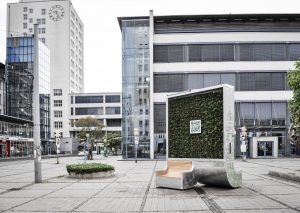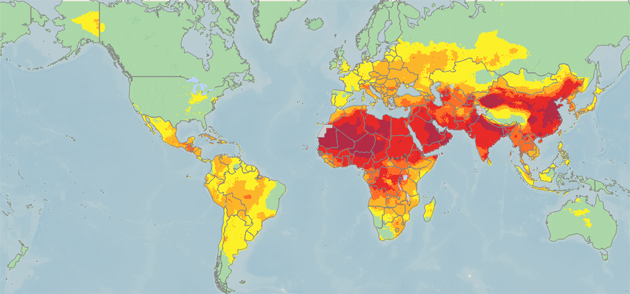Street air purifier launched by German company might eliminate polluted air. How the world tackles with air pollution, one of the main causes of mortality
A German company launched a street air purifier which, despite its small size, absorbs a huge amount of pollutants, being the equivalent to that of 275 trees. The purifier, available at a reasonable price for the promised results, might be the ideal solution for the world’s largest cities which, due to heavy traffic and developed industry, are being suffocated by the polluted air, one of the main causes of mortality on a world level.
CityTree air purifier, launched by Green City Solutions, is a device that includes moss and other plants. Standing 4 meters tall and being 3 meters wide, CityTree has the capacity of absorbing 240 tonnes of carbon dioxide and other impurities in the air, according to the initiators of the project, who state that a single such panel is the equivalent of 275 trees on a single square meter, but needs only 3 sqm in order to be placed on the ground. It can, therefore, be used in the intersections in large cities in order to lower pollution.
At the same time, the panel, available at a cost of about $25,000, also has the role of reducing the heat of the air surrounding it and lowers sound pollution.
Its inventors also found a way to ensure CityTree’s profitability. Thus, on the vertical plant can be implemented visual and digital information to show marketing campaigns or analogue information, like a simple writing or logo, which can be displayed also with the help of plants available in different colours.
“Our system enables access to digital content by implementing technologies such as a QR-Code, NFC or digital screens. This makes it possible to use the CityTree for out of home media advertising as well as mobile commerce purposes. Integrated benches and the offer of additional services, such as Wi-Fi hotspot or e-bike charging stations extend the functionality of the CityTree,” the company informs.

Green City Solutions was founded in March 2014 by a team which combines expertise in architecture, informatics, engineering and horticulture: Dénes Honus, Victor Splittgerber, Liang Wu and Peter Sänger, in order to develop highly efficient and sustainable solutions to improve the environment for the cityscape of tomorrow.
”Every day 90% of cities’ inhabitants breathe polluted air which becomes the cause of every 7th death worldwide. The major components of air pollution are nitrogen oxides, ozone and especially fine dust (PM), of which 10µg per m³ of air shorten the life span by half a year. At the same time, the global population goes urban and in 2050 80% of world’s population will live in cities. Green City Solutions addresses this global problem by combining a special, vertical installed moos culture, with our own developed Internet-of-Things (IoT) technology for its optimal maintenance,” the company formerly announced.
The plant filter was produced using recyclable material to lower our carbon footprint and contains sensors collecting environmental and climatic data, to regulate and control the unit and ensure that the plants survive. CityTree can be adapted to any environment and has solar panels and rainwater retention systems, therefore the unit requires only a few hours of maintenance per year.
Green City Solutions was declared, in October 2014, as one of the four best CleanTech startups in Europe by the EU organisation Climate-KIC, the biggest European innovation initiative for climate-friendly technologies.
Until now, several dozens such devices were introduced in various countries worldwide, such as Hong Kong, Norway, Germany, Belgium, Italy and Macedonia, but the company plans on starting similar projects in other countries with lower income, such as India.
“We see the CityTree as an essential part of future environmental urban planning. Therefore the next logical step is the testing over a longer period under real urban conditions. We believe that the confirmation of the laboratory proven results will help Green City Solutions to convince potential customers such as cities and municipalities to install the smart plant filters”, said Björn Grindberg, Innovation Lead at Climate-KIC, in February, when was launched a two-year research project, “CityTree Scaler”, through which were installed six CityTrees, in the most polluted street in the Italian city of Modena, one of the main hot-spot of air pollution in Europe, in order to prove the effectiveness of the smart biotechnological filter “CityTrees” in an urban environment, with regards to its ability to face air pollution, improve biodiversity and reduce heat island effects.
WHO: Polluted air the most deadly consequence of environmental degradation
According to World Health Organization, nine out of 10 people globally are breathing poor quality air, pollution being blamed for more than six million deaths a year with air pollution being the leading environmental cause of death.
Nearly 90% of air-pollution-related deaths occur in low- and middle-income countries, with almost 2 out of 3 occurring in WHO’s South-East Asia and Western Pacific regions.
“WHO estimates that outdoor and indoor air pollution killed 6.5 million people yearly, making polluted air the most deadly consequence of environmental degradation. Air pollution is one of the most pernicious threats to health because it is so pervasive. No one can escape it. Everyone has to breathe. When breathing becomes deadly, entire cities become a hazard to health,” WHO announced previously.

Major sources of air pollution include inefficient modes of transport, household fuel and waste burning, coal-fired power plants, and industrial activities. However, not all air pollution originates from human activity. For example, air quality can also be influenced by dust storms, particularly in regions close to deserts.
Of the deaths recorded worldwide, nearly 1,4 million premature deaths, due to environmental pollution, are registered in Europe and Central Asia. According to a recent report from the United Nations, European citizens lose every year 50 million years of healthy life due to environmental risks. These are responsible for 15% of the total number of deaths registered on the continent.
Environmental risk factors are responsible for 26% of the coronary heart disease cases, 25% of strokes and 17% of cancer cases in Europe.
The same source writes that air pollution is the leading environmental risk factor that leads to deaths in Europe, with 620,000 people dying every year because of it.
The coal industry kills more Americans than it employs
Also, a recent report revealed that one in four Americans, respectively 125 million people, live in counties with unhealthful levels of air pollution and though over the last year the situation has been improving, there are still dangerous spikes in particle pollution that put people in danger.
How many children around the world die due to air pollution
Worldwide, over 1 in 4 deaths of children under 5 years of age are attributable to unhealthy environments, according to WHO. ”Every year, environmental risks – such as indoor and outdoor air pollution, second-hand smoke, unsafe water, lack of sanitation, and inadequate hygiene – take the lives of 1.7 million children under 5 years,” say two new WHO reports.
“A polluted environment is a deadly one – particularly for young children,” said Dr Margaret Chan, WHO Director-General. “Their developing organs and immune systems, and smaller bodies and airways, make them especially vulnerable to dirty air and water.”
According to the same source, harmful exposures can start in the mother’s womb and increase the risk of premature birth. Additionally, when infants and pre-schoolers are exposed to indoor and outdoor air pollution and second-hand smoke they have an increased risk of pneumonia in childhood, and a lifelong increased risk of chronic respiratory diseases, such as asthma. Exposure to air pollution may also increase their lifelong risk of heart disease, stroke and cancer.
“Air pollution continues to take a toll on the health of the most vulnerable populations – women, children and the older adults,” said Dr Flavia Bustreo, Assistant Director-General at WHO. “For people to be healthy, they must breathe clean air from their first breath to their last.”
Around 600,000 children under age 5 die every year from diseases caused by or exacerbated by outdoor and indoor air pollution, especially in poor nations, UNICEF Executive Director Anthony Lake said in the introduction to a report titled “Clear the Air for Children.” Air pollution also hurts children it doesn’t kill, including the unborn. According to the NGO, air pollution leads to the deaths of more children yearly than malaria and HIV/AIDS combined.
Air pollution is also an important factor that contributes every year to millions of premature births all through the world, a wide study conducted by scientists from Stockholm Environment Institute (SEI), the London School of Hygiene and Tropical Medicine and the University of Colorado.
“WHO’s Ambient Air quality guidelines” of particulate with a diameter of less than 2.5 micrometres (PM2.5) are 10 μg/m3 annual mean. PM2.5 includes pollutants such as sulphate, nitrates and black carbon, which penetrate deep into the lungs and in the cardiovascular system, posing the greatest risks to human health.

WHO points out that reducing air pollution inside and outside households, improving safe water and sanitation and improving hygiene (including in health facilities where women give birth), protecting pregnant women from second-hand tobacco smoke, and building safer environments, can prevent children’s deaths and diseases.
The bike designed to clean the air while you ride
Green City Solutions’ CityTrees are not the only solutions invented which caught up the attention in the fight against air pollution. Daan Roosegaarde introduced a bike design that is supposed to clean the air while you ride, which inhales polluted air, cleans it and releases clean air around the cyclist.
Forest Cities to tackle China’s deadly air pollution
This year, the Italian architect Stefano Boeri announced China’s first vertical forest, a concept popularised in Milan, which is brought to Nanjing, China. The project consists in two green towers which will host 1,100 flourishing trees from 23 local species, as well as 2,500 cascading shrubs and plants, that could produce around 60 kg of oxygen per day.
Then, a few weeks later, he unveiled a more ambitious project called Forest Cities. The first city where the new project will be implemented is Liuzhou, and construction is expected to begin later this year.
“We have been asked to design an entire city where you don’t only have one tall building but you have 100 or 200 buildings of different sizes, all with trees and plants on the facades,” Boeri said, approximating that by 2020 China could have the first forest city.
The “pollution vacuum cleaner”, the Dutch solution against pollution
Envinity Group, a start-up from Amsterdam, came up with an unusual invention against air pollution – the “pollution vacuum cleaner”, which, according to its inventor, filters 100% of the fine particles in the air and 95% of the ultrafine ones. It can “inhale” the air from a radius of 300 meters and is capable of filtering 800,000 cubic meters of air per hour.
“It is a huge industrial filter, circa eight meters long, made of steel, that would be placed on the roof of buildings and that works like a giant vacuum cleaner. Through it go columns of air that it filters and it then eliminates clean air”, Henk Boersen, a spokesperson of the company explained.